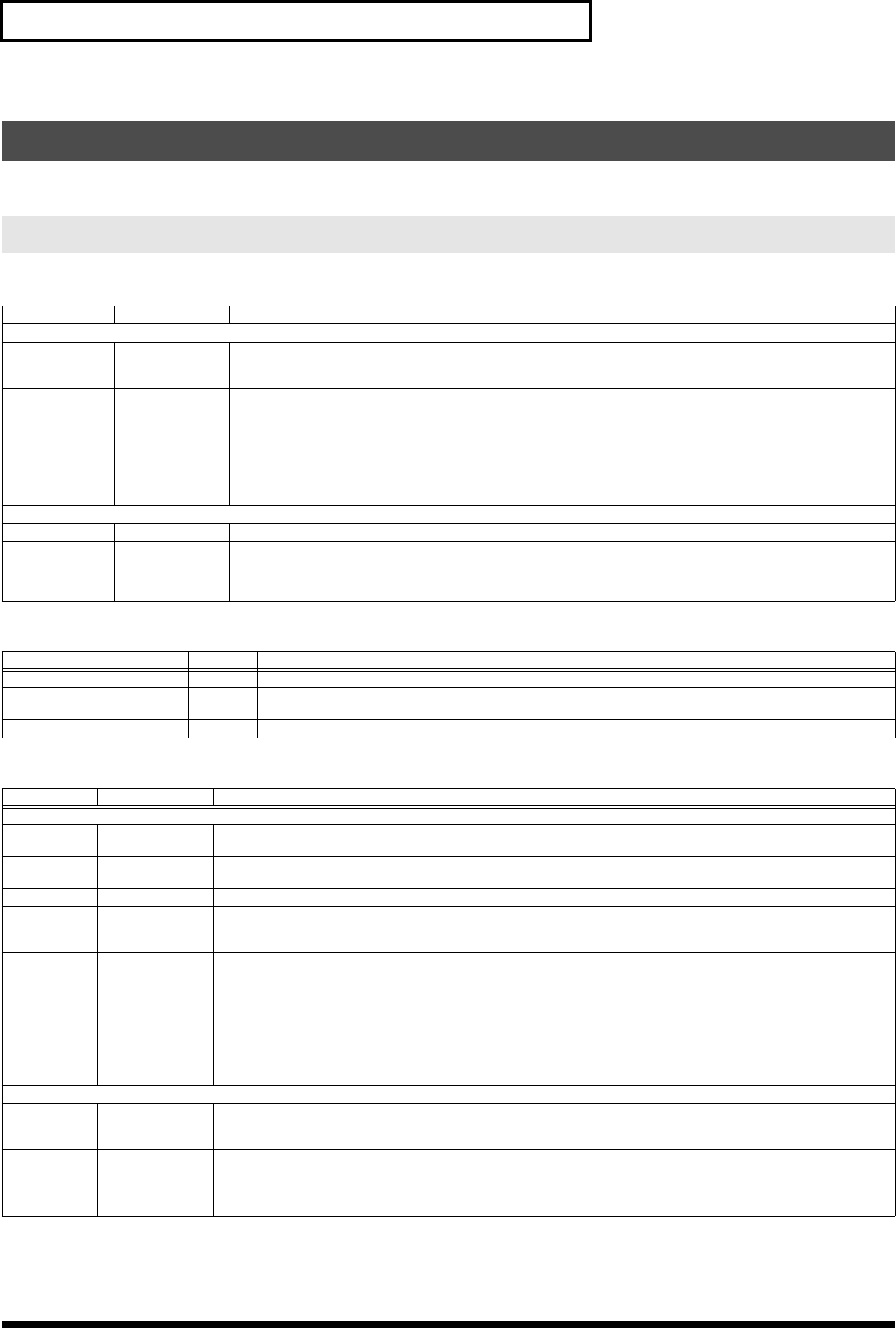
158
Settings Common to All Modes (System Function)
This section explains what the different System parameters do, and also how these parameters are organized.
[F1 (COMMON)]
[F2 (AUTO LD)]
[F3 (SOUND)]
Functions of System Parameters
System Menu [F1 (GENERAL)]
Parameter
Value Explanation
System Common
Power Up Mode
PATCH,
PERFORMANCE
Mode that the JUNO-G will be in when it is powered up.
PATCH:
Patch mode
PERFORMANCE:
Performance mode
Patch Remain OFF, ON Specifies whether currently sounding notes will continue sounding when another patch or rhythm set is selected (ON), or
not (OFF).
Also, when this is “ON,” changes produced by incoming MIDI messages such as Volume or Pan (CC 5, 7, 10, 65, 68, 71–
74, RPN 0, 1, 2, MONO ON, POLY ON), as well as tonal quality and volume changes produced by the various control-
lers will be inherited.
* Effects settings change as soon as you switch to a new patch or rhythm set, without being influenced by the Patch Remain setting.
Because of this, certain effects settings can cause notes that were until then sounding to no longer be heard, even though Patch
Remain has been set to “ON.”
Audio Rec
Default File Type
WAV, AIFF File format used when saving a sample
Input Select LINE IN L/R,
LINE IN L,
MICROPHONE
Input source of the external input sound
LINE IN L/R:
L/R (stereo)
LINE IN L:
L (mono)
MICROPHONE:
L (mono, mic level)
Parameter
Value Explanation
Load Preset Samples at Startup
OFF, ON Specifies whether the preset samples will be loaded into memory at power-on (ON) or not (OFF).
Load User Samples at Startup OFF, ON Specifies whether the samples of the user area and memory card will be loaded into memory at power-on (ON) or
not (OFF).
Load Demo Song at Startup OFF, ON Specifies whether the demo song will be loaded into the temporary area at power-on (ON), or not (OFF).
Parameter
Value Explanation
Sound Generator
Master Tune
415.3–466.2 Hz Overall tuning of the JUNO-G
The display shows the frequency of the A4 note (center A).
Master Key
Shift
-24– +24 Shifts the overall pitch of the JUNO-G in semitone steps.
Master Level 0–127 Volume of the entire JUNO-G
Output Gain -12– 12 dB Output gain from the JUNO-G’s Output
When, for example, there are relatively few voices being sounded, boosting the output gain can let you attain the most
suitable output level for recording and other purposes.
Mix/Parallel MIX, PARALLEL How the sound of the entire JUNO-G will be output
MIX:
Set this to have the collective output of all sounds output from the OUTPUT A (MIX) jacks. When you want to check
the final overall sound being output, set to MIX.
PARALLEL:
Output according to each Output Assign settings.
* Sounds which are set in the respective Output Assign to be output from the INDIVIDUAL 3 jack are output from the left OUTPUT
A (MIX) jack; sounds which are set to be output from the INDIVIDUAL 4 jack are output from the right OUTPUT A (MIX) jack.
* Sounds output from the PHONES jack are the same as those output from the OUTPUT A (MIX) jacks. Therefore, any sounds set with
Output Assign to be output from the OUTPUT B jacks is not output from the PHONES jack. Be sure to have any sound you want to
hear through the headphones set to “MIX.”
Preview
Preview
Mode
SINGLE,
CHORD,
PHRASE
SINGLE:
The notes specified by Preview 1–4 Note Number will sound successively one by one.
CHORD:
The notes specified by Preview 1–4 Note Number will sound simultaneously.
PHRASE:
The Phrase associated with the patch’s type/category is played.
Preview 1–4
Note Number
C - –G9 Specify the pitch of the four notes that will sound when the Preview Mode is set to “SINGLE” or “CHORD.”
* If “PHRASE” is selected for the Preview Mode parameter, these settings will have no effect.
Preview 1–4
Velocity
OFF, 1–127 Specify the velocity of the four notes that will sound when the Preview Mode is set to “SINGLE” or “CHORD.”
* If “PHRASE” is selected for the Preview Mode parameter, these settings will have no effect.
JUNO-G_e.book 158 ページ 2006年2月13日 月曜日 午後2時44分


















